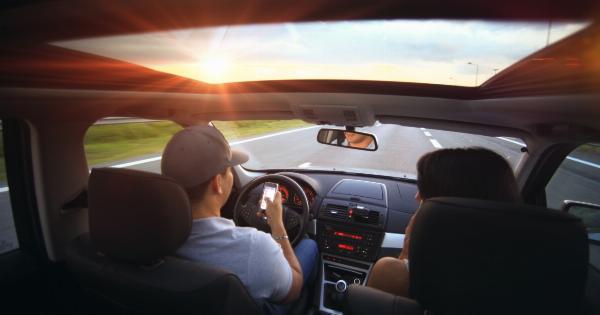Driving is an activity that demands full attention and concentration to prevent accidents. However, many drivers still engage in different behaviors that put them and other road users at risk.
Two of these dangerous behaviors are driving while using mobile phones and driving under the influence of alcohol.
Driving while Using Mobile Phones
In recent years, the use of mobile phones while driving has become widespread. Many drivers make calls, compose and read text messages, scroll through social media, or use GPS while driving.
However, these activities distract drivers, reducing their reaction times and ability to make sound judgments. As a result, driving while using mobile phones has become a significant cause of accidents, injuries, and fatalities.
The Statistics
According to the National Safety Council, cell phone use while driving leads to 1.6 million crashes each year in the US alone, and a quarter of all accidents involve cell phone use.
These accidents result in tens of thousands of deaths and injuries and cost the economy billions of dollars in medical bills, lost productivity, property damages, and legal fees.
The Risks
Driving with one hand on the wheel and one eye on the phone screen means that drivers are not fully aware of their surroundings. They may miss important traffic signs, signals, or sounds that alert them to hazards.
They may not see pedestrians, bikers, or other cars in their blind spots. They may not be able to avoid sudden obstacles or changes in traffic patterns, such as construction zones, detours, or accidents. They may also drift out of their lanes or drive at erratic speeds, posing a danger to others on the road.
The Consequences
The consequences of driving while using mobile phones can be severe. They range from minor injuries, such as cuts, bruises, and sprains, to major injuries, such as broken bones, head trauma, and permanent disability.
They can also lead to psychological trauma, such as post-traumatic stress disorder (PTSD), anxiety, and depression. In the worst cases, they result in death, leaving families and communities devastated.
Driving under the Influence of Alcohol
Another dangerous behavior that many drivers engage in is driving under the influence of alcohol.
Drinking alcohol impairs judgment, slows reaction times, and reduces coordination, making it difficult for drivers to control their vehicles, avoid hazards, and react to emergencies. As a result, driving under the influence of alcohol is a leading cause of accidents, injuries, and fatalities.
The Statistics
According to the National Highway Traffic Safety Administration (NHTSA), drunk driving accounts for about one-third of all traffic-related fatalities in the US.
Every day, about 30 people die in alcohol-related crashes, which is equivalent to one death every 50 minutes. In addition, hundreds of thousands of people are injured or disabled, and the economic cost of drunk driving is estimated to be over $44 billion per year.
The Risks
Alcohol affects different drivers in different ways, depending on factors such as age, weight, gender, and tolerance. However, even a small amount of alcohol can impair driving abilities, such as vision, perception, coordination, and judgment.
Drivers under the influence of alcohol may swerve, weave, speed, brake abruptly, or ignore traffic signals. They may also become aggressive, drowsy, or confused, and are more likely to engage in risky behaviors, such as speeding, tailgating, or ignoring seat belts.
The Consequences
The consequences of drunk driving are devastating. They include physical injuries, such as bruises, cuts, fractures, and internal bleeding, as well as long-term disabilities, such as paralysis, brain damage, and amputation.
They can also lead to emotional trauma, such as guilt, shame, and depression, and often result in legal, financial, and social problems, such as fines, jail time, job loss, and social stigma. In the worst cases, drunk driving leads to death, leaving families and communities grieving.
Comparison
While both driving while using mobile phones and driving under the influence of alcohol are dangerous behaviors that increase the risk of accidents and injuries, they differ in several ways.
Distraction vs. Impairment
Driving while using mobile phones is a form of distraction, as it diverts drivers’ attention from the road and reduces their awareness of their surroundings.
In contrast, driving under the influence of alcohol is a form of impairment, as it affects drivers’ physical and mental abilities and makes them incapable of driving safely.
Legal Status
Driving while using mobile phones is illegal in many states and carries fines, points, or license suspensions. However, it is often difficult to enforce, as it is hard to catch drivers in the act of using their phones.
On the other hand, driving under the influence of alcohol is a serious crime that carries criminal charges, fines, and jail time, and is easier to detect through tests such as breathalyzers.
Social Acceptance
Driving while using mobile phones is often viewed as a minor offense or a common habit, especially among young drivers.
In contrast, driving under the influence of alcohol is widely condemned as reckless, irresponsible, and dangerous, and is associated with stigma and shame.
Risk Factors
The risk factors for driving while using mobile phones differ from those for driving under the influence of alcohol.
Younger drivers, especially males, are more likely to use mobile phones while driving, while older, more experienced drivers are more likely to drive under the influence of alcohol. In addition, drivers who have had previous accidents or violations, who drive at night, or who have a history of drug or alcohol abuse are more likely to engage in either behavior.
Conclusion
Driving while using mobile phones and driving under the influence of alcohol are two dangerous behaviors that pose a threat to the lives and well-being of drivers and others on the road.
While both behaviors differ in their causes, effects, and legal status, they share a common root: the lack of responsibility and awareness on the part of drivers. Learning about the risks and consequences of these behaviors, as well as the legal and social repercussions, can help raise awareness and promote safer driving habits.































